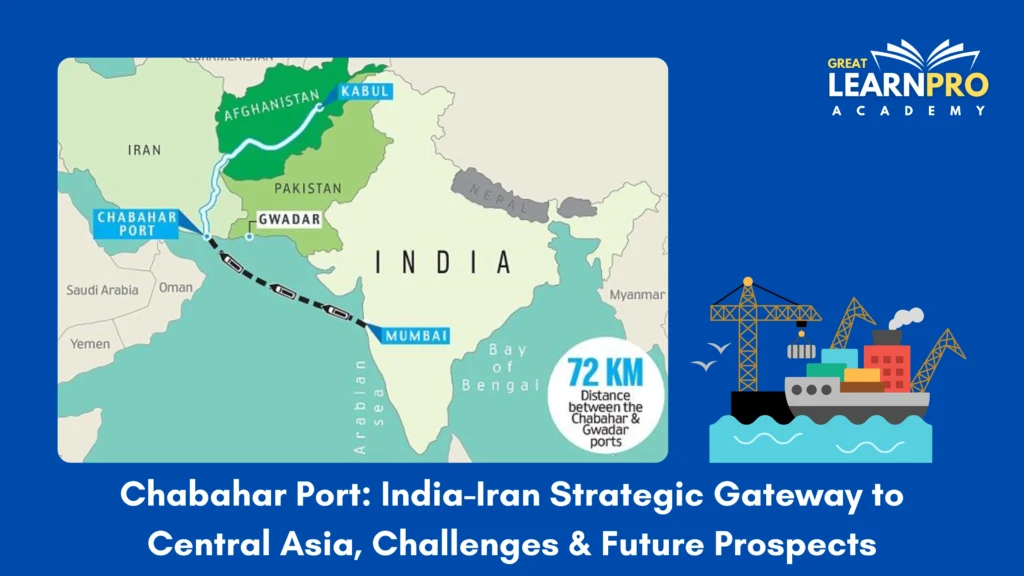The Chabahar Port, located in southeastern Iran along the Gulf of Oman, holds immense strategic significance for India, Iran, Afghanistan, and the wider region. Often described as India’s gateway to Central Asia, the port provides an alternative trade route bypassing Pakistan, enabling direct connectivity to Afghanistan and beyond into the energy-rich Central Asian republics. The port has also been seen as a counterbalance to Pakistan’s Gwadar Port, developed with Chinese assistance, and thus forms a vital component of India’s regional strategic and economic calculus.

India and Iran first signed an agreement in 2003 to jointly develop Chabahar, but progress was slow due to international sanctions on Iran. It was only in 2016, following the signing of the Joint Comprehensive Plan of Action (JCPOA), that the project gained momentum with the Trilateral Agreement between India, Iran, and Afghanistan. This pact allowed Indian goods to reach Afghan markets via Chabahar, avoiding Pakistan, which had consistently denied India overland transit access.
For India, Chabahar symbolizes not just trade opportunities but also geopolitical leverage. The port is critical for India’s investments in infrastructure projects like the Zaranj-Delaram highway in Afghanistan and is often linked with the larger International North-South Transport Corridor (INSTC) connecting India to Russia and Europe. The port’s success could transform regional connectivity, enhance India’s role in Eurasian trade, and provide landlocked Afghanistan with greater independence in its trade relations.
However, despite its potential, Chabahar Port has faced numerous challenges and recent issues that have slowed down its development. One of the most significant hurdles has been the re-imposition of U.S. sanctions on Iran after the U.S. withdrew from the JCPOA in 2018. Although India initially received waivers for its involvement in Chabahar, the uncertainty surrounding sanctions discouraged investment and financial transactions. Many international companies and banks were reluctant to engage, fearing repercussions from the U.S.
Another pressing issue has been the political instability in the region. Iran’s strained relations with Western powers and increasing tensions in West Asia have created doubts about the long-term stability of the project. Furthermore, Afghanistan’s changing political situation after the Taliban’s return to power in 2021 has complicated matters. The port’s relevance was closely tied to Afghanistan’s needs, but shifting power dynamics have altered trade priorities and created unpredictability in regional cooperation.
More recently, the Iran-India partnership itself has witnessed strains. While India remains committed to Chabahar, delays in fulfilling investment commitments and differences over terms of development have slowed progress. Iran, seeking to expand its own options, has engaged with other countries, including China, for development projects, which has raised concerns in New Delhi about losing strategic influence.
Additionally, there are infrastructure-related issues. Despite India’s operational control of a terminal at Chabahar since 2018, the pace of development of supporting facilities such as rail connectivity to Afghanistan has been slow. This has limited the port’s functionality as a full-fledged transit hub. Rising regional competition, particularly from Gwadar Port in Pakistan under the China-Pakistan Economic Corridor (CPEC), has further highlighted the need for India and Iran to expedite Chabahar’s progress.
In the current global context, Chabahar Port faces a complex mix of opportunities and challenges. On one hand, its geographical position ensures it will remain a critical player in regional connectivity plans. On the other hand, geopolitical frictions, sanctions, and regional rivalries continue to restrict its full potential. The future of Chabahar will depend largely on whether India and Iran can resolve their differences, attract greater investment, and insulate the project from the impact of international politics.
In conclusion, Chabahar Port is not just a commercial venture but a symbol of regional aspirations for greater connectivity and cooperation. Its recent issues underline the difficulties of balancing strategic interests with shifting geopolitical realities. If managed effectively, it can still emerge as a cornerstone of India’s regional outreach and an important pillar of West and Central Asian trade architecture.
SOURCES
- https://www.indiatoday.in/business/story/india-signs-10-year-deal-with-iran-to-manage-chabahar-port-2538654-2024-05-13?utm_
- https://timesofindia.indiatimes.com/india/india-iran-ink-10-year-pact-to-equip-operate-chabahar-port/articleshow/110094403.cms?utm_
- https://www.thehindu.com/news/national/india-and-iran-drop-foreign-court-arbitration-for-chabahar-port/article67234071.ece?utm_
More Current affairs: https://learnproacademy.in/updates/
